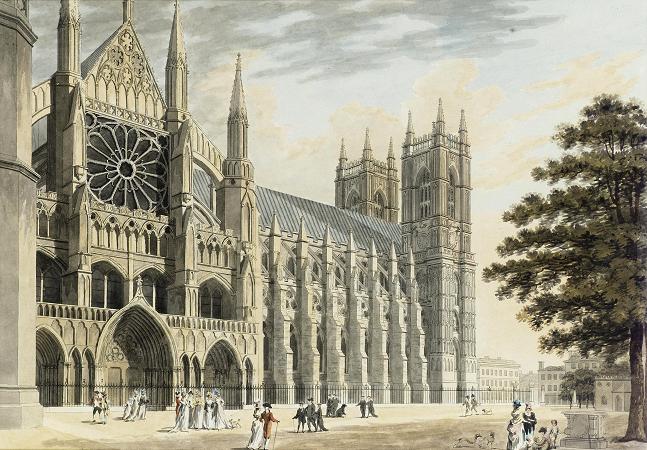Westminster Abbey. Westminster Abbey, formally titled the Collegiate Church of Saint Peter at Westminster, is a large, mainly Gothic abbey church in the City of Westminster, London, England, just to the west of the Palace of Westminster. The Abbey was a popular subject in medieval illuminated manuscripts, which often depicted scenes from the Bible or religious ceremonies taking place within the abbey. These manuscripts were richly decorated with gold leaf and intricate designs, and were intended to convey the grandeur and spiritual significance of the abbey. It has also been the subject of numerous architectural drawings and plans, which document the various stages of its construction and renovation over the centuries. These drawings often focus on the abbey's Gothic architecture, with its soaring arches, intricate carvings, and stained glass windows. It has been depicted in many paintings throughout history, ranging from formal portraits of monarchs and other important figures associated with the abbey, to more impressionistic scenes of the abbey's interior and exterior. One famous example is J.M.W. Turner's painting The Fighting Temeraire, which shows the ship being towed past the abbey towards its final berth in 1838. In more recent times, Westminster Abbey has been the subject of countless photographs, which capture the abbey's architectural beauty and historical significance from a variety of angles and perspectives. These photographs often focus on the abbey's exterior, with its iconic towers and spires, as well as its interior, with its ornate tombs, chapels, and stained glass windows. Westminster Abbey has been portrayed in art as a symbol of religious and political power, as well as a testament to the skill and creativity of the architects, artists, and craftsmen who have contributed to its construction and decoration over the centuries. Whether through illuminated manuscripts, architectural drawings, paintings, or photographs, the abbey continues to inspire and captivate artists and viewers alike. It is one of the United Kingdom's most notable religious buildings and the traditional place of coronation and burial site for English and, later, British monarchs. The building itself was a Benedictine monastic church until the monastery was dissolved in 1539. Between 1540 and 1556, the abbey had the status of a cathedral. Since 1560, the building is no longer an abbey or a cathedral, having instead the status of a Church of England Royal Peculiar, a church responsible directly to the sovereign. According to a tradition first reported by Sulcard in about 1080, a church was founded at the site in the seventh century, at the time of Mellitus, a Bishop of London. Construction of the present church began in 1245, on the orders of King Henry III. Since the coronation of William the Conqueror in 1066, all coronations of English and British monarchs have been in Westminster Abbey. There have been 16 royal weddings at the abbey since 1100. As the burial site of more than 3,300 persons, usually of predominant prominence in British history, Westminster Abbey is sometimes described as Britain's Valhalla, after the iconic burial hall of Norse mythology. A late tradition claims that Aldrich, a young fisherman on the River Thames, had a vision of Saint Peter near the site. This seems to have been quoted as the origin of the salmon that Thames fishermen offered to the abbey in later years-a custom still observed annually by the Fishmongers' Company. The recorded origins of the Abbey date to the 960s or early 970s, when Saint Dunstan and King Edgar installed a community of Benedictine monks on the site. Between 1042 and 1052, King Edward the Confessor began rebuilding St Peter's Abbey to provide himself with a royal burial church. It was the first church in England built in the Romanesque style. The building was completed around 1060 and was consecrated on 28 December 1065, only a week before Edward's death on 5 January 1066. A week later, he was buried in the church; and, nine years later, his wife Edith was buried alongside him. His successor, Harold II, was probably crowned in the abbey, although the first documented coronation is that of William the Conqueror later the same year. The only extant depiction of Edward's abbey, together with the adjacent Palace of Westminster, is in the Bayeux Tapestry.
more...









